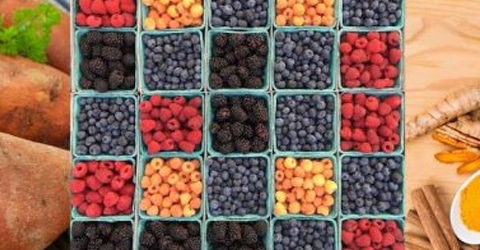

Why do we feel sore after a workout? Inflammation plays a major role. Acute inflammation is a natural response to an effective workout, and feeling a bit sore can be a sign that your body is healing itself. This temporary inflammation is nothing to worry about. Chronic inflammation, however, can get you into trouble. Multiple components of dairy—such as trans fat and the foreign sugar Neu5gc—trigger an inflammatory response. Over time (say, a serving of chocolate cows’ milk after every workout), this response can put your body in a chronic inflammatory state—putting it at risk for serious diseases.
A simple way to reduce your risk of chronic inflammation is to ditch dairy. To address acute inflammation and speed up your workout recovery process, eliminate dairy, then consider a few other proactive measures. While food alone shouldn’t replace your solid recovery routine (rest, foam rolling, ice baths, etcetera), incorporating these inflammation-fighting plant foods may significantly speed up your recovery time and get you back in action.[1]
1. Select Spices
Many common spices have anti-inflammatory properties, but ginger and turmeric are inflammation-fighting powerhouses, and it doesn’t take much. Sprinkle them into tofu or chickpea scrambles, soups, and roasted veggies, or add a tiny pinch of each to your smoothies.
2. Dark Leafy Greens
Kale, collards, spinach—all fair game here. Massage your kale and let it sit for a few hours in a delicious tahini dressing for a tender kale salad; cook down collard greens with garlic and onions; or toss a few handfuls of fresh or frozen spinach into a stir-fry.
3. Select Fruits
Think strawberries, blueberries, oranges, and cherries. Enjoy these fruits on their own, in a smoothie, or blended with frozen bananas for a sweet dairy-free frozen yogurt-like dessert.
4. Nuts
Stock up on walnuts, almonds, and hazelnuts. Slightly roast them and make your own nut butter (or purchase a store bought variety). Nuts also round out salads and add texture to amazing acai bowls.
5. Tomatoes
Think you don’t like tomatoes? Try a different variety. From cherry to Roma to heirloom, tomatoes come in all tastes and textures. Use them to top a dairy-free veggie pizza; make a plant-based bolognese sauce; or whip up a dairy-free tomato, cucumber, and tofu feta salad.
6. Beans
Pinto, garbanzo, black, or kidney—there are literally dozens of different bean varieties to suit any preference. Whether you purchase them in a can or make your own from dried, beans still retain their inflammation-fighting properties. Simmer a hearty bean chili; wrap up a bean and vegetable burrito; or make a dip to dunk raw veggies or schmear onto sandwiches and wraps.
What do these foods have in common? Antioxidants! Antioxidants are compounds that aid in both the prevention and repair of cell and tissue damage—often caused by inflammation.[2] While dairy is exceedingly low in antioxidants, plant-based foods tend to be extremely high in these compounds.
The fuel we choose to put into our bodies makes a difference not only in our athletic performance, but in our overall lives. Try it for one week. Ditch dairy (if you haven’t already), incorporate these inflammation-fighting foods into your diet, and take stock of how you feel. Inflammation doesn’t have to be an inevitable burden you must learn to cope with—a simple thing such as eating a spinach salad with walnuts and chickpeas can make all the difference.
*This article is reprinted with permission from Switch4Good.
Copyright 2024 Center for Nutrition Studies. All rights reserved.